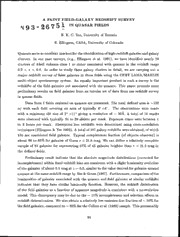
NASA Technical Reports Server (NTRS) 19930017562: A faint field-galaxy redshift survey in quasar fields PDF
Preview NASA Technical Reports Server (NTRS) 19930017562: A faint field-galaxy redshift survey in quasar fields
A FAINT FIELD-GALAXY REDSHIFT SURVEY IN QUASAR FIELDS H. K. C. Yee, University of Toronto E. Ellingson, CAS A, University of Colorado Quasars serve as excellent markers for the identification of high-redshift galaxies and galaxy clusters. In our past surveys, (e.g., Ellingson et al. 1991), we have identified nearly 20 clusters of Abell richness class 1 or richer associated with quasars in the redshift range 0.2 < z < 0.8. In order to study these galaxy clusters in detail, we are carrying out a major redshift survey of faint galaxies in these fields using the CFHT LAMA/MARLIN multi-object spectroscopy system. An equally important product in such a survey is the redshifts of the field galaxies not associated with the quasars. This paper presents some preliminary results on field galaxies from an interim set of data from our redshift survey in quasar fields. Data from 7 fields centered on quasars are presented. The total defined area is ~130 sq1 with each field covering an area of typically 6' x4' . The observations were made with a minimum slit size of 2" xll" giving a resolution of ~ 20A. A total of 16 masks were observed with typically 24 to 28 slitlets per mask. Exposure times were between 1 to 3 hours per mask. Absorption line redshifts were determined using cross-correlation techniques (Ellingson & Yee 1992). A total of 197 galaxy redshifts were obtained, of which 135 are considered field galaxies. Typical completeness fraction (of objects observed) is about 80 to 85% for galaxies of Gunn r < 21.5 mag. We can define a relatively complete sample of 94 galaxies for representing 57% of all galaxies brighter than r < 21.5 mag in the defined fields. Preliminary result indicate that the absolute magnitude distributions (corrected for incompleteness) within fixed redshift bins are consistent with a slight luminosity evolution of the galaxies of about 0.5 mag at z ~ 0.5, similar to the value derived for galaxies around quasars at the same redshift range by Yee & Green (1987). Furthermore, comparison of the luminosities of galaxies associated with the quasars and field galaxies at similar redshifts indicates that they have similar luminosity function. However, the redshift distribution of the field galaxies as a function of apparent magnitude is consistent with a no-evolution model. This discrepancy may be due to the ~ 15% incompleteness and selection effects in redshift determination. We also obtain a relatively low emission-line fraction of ~ 50% for the field galaxies, compared to ~ 80% for the Colless et al. (1989) sample. This presumably 94 reflects the dominance of early-type galaxies in a red-selected sample. However, there may also be a large field-to-field variation in the number of emission line galaxies. The colors of the galaxies are entirely consistent with their emission-line characteristics. Several fields show remarkable structures in redshift space, including one which shows at least 3 "sheets" of redshifts besides that of the quasar cluster. References Colless, M., Ellis, R., Taylor, K. & Hook, R. 1989, MNRAS, 244, 408. Ellingson, E. & Yee, H. K. C. 1992, preprint submitted to AJ. Ellingson, E., Yee, H. K. C. & Green, R. F. 1991, ApJ, 371, 49. 95
